Hydrangea for the Moscow region: varieties, planting and care

One of the most beautiful and low-maintenance plants that combines grace, splendor, duration of flowering and variety of varieties is hydrangea. Every gardener will appreciate the beauty of flowering and the variety of inflorescences of this amazing flower. Gardeners and florists of Moscow and the Moscow region are no exception. Using knowledge, they will be able to choose from all known species the most suitable for the territory of the Moscow region.

Suitable species
There are an incredibly large number of types of hydrangea: tree, serrate, broad-leaved, paniculate, climbing and others. But unfortunately, due to the unfavorable winter conditions of the Moscow region, not all of them can be grown outdoors, and they will have to be sheltered for the winter period... Otherwise, the plant may die. Several types are considered the best for the Moscow region.

Paniculata
To distinguish the paniculate hydrangea from its other representatives, you need to pay attention to some signs.
- The inflorescences of the plant resemble the shape of a panicle, which in turn consists of a large number of small flowers. Flowers are divided into 2 types: beautiful barren flowers and not so bright, but fruiting.
- The length of the panicles reaches 25 cm, sometimes even more.
- The shape of the panicles and their "fluffiness" are different for all varieties. The more barren flowers on the branches, the more magnificent, beautiful, richer and more unusual the plant looks.
Most types of panicle hydrangea change the color of the inflorescences during the flowering season. So, in the spring you can observe the pure white color of the petals, in the summer - delicate pink, gray-green, and in the fall - up to cherry. Almost all types of flowers emit a pleasant scent.

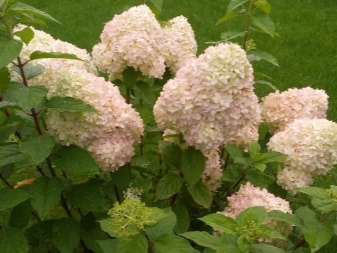
The age of a shrub can reach 60 years, provided that it grows in the same place. The hydrangea grows about 30 cm each year. Before planting paniculate hydrangea, it is recommended that you first study the description of the plant, the characteristics of the variety and the features of care. There are 2 ways of growing hydrangeas: the plant is formed as a multi-stem shrub or as a standard tree. To prevent the seedling from growing too tall, it must be pruned. Then it will take the form of a lush "cap" and will remain at the level of 1.5-2 m.

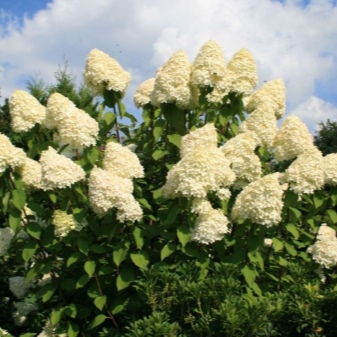
Broadleaf (large-leaved)
This species was bred in Europe, in particular, in France, and the plant itself comes from Japan. The broadleaf hydrangea, once in a favorable environment, can grow to the size of a large, spreading shrub. It has its own characteristics, thanks to which you can recognize it.
- The leaves are large, ovate, in opposite order.
- The plant is considered decorative, since the color of the leaves changes several times over the season. In spring and summer, they acquire shades from bright green to deep green, and in autumn they turn red.
- It blooms in large corymbose inflorescences up to 20 cm in diameter, the size of each flower is about 3 cm in diameter. The color is mostly pink, but newer varieties can be white or blue.
- The peak of flowering occurs in July, but at the end of it, the flowers do not crumble, but remain until the next season, while turning green.


Previously, the large-leaved hydrangea was considered a houseplant and was grown in pots. But thanks to progress in the field of breeding varieties, new frost-resistant species have appeared.
This plant has another surprising difference: by the color of the flowers, you can determine the level of acidity of the soil. So, the pink color of the inflorescences indicates a low alkalinity of the soil, and blue or blue are considered an indicator of the increased acidity of the earth.

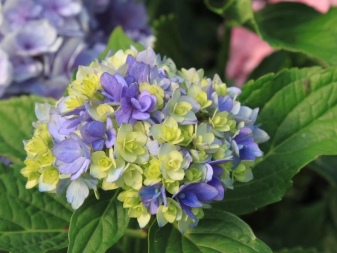
Climbing
This type of hydrangea is also called petiolate, curly or climbing hydrangea. Unlike paniculate or broad-leaved, in the gardens of the Moscow region, it is not very common. Outwardly, it resembles a long liana, studded with thyroid panicles with flowers. It grows both vertically, attaching itself to any irregularities, and spreads horizontally along the surface.
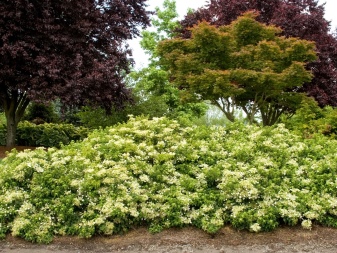

In height, hydrangea liana can stretch up to 25 m. It blooms with beautiful, rather large inflorescences, reaching 20 cm in diameter, differing in the duration of flowering. Flowers that are white or pale creamy with a pinkish tint exude a pleasant aroma. Flowering occurs in June or July. The foliage of the plant is very different, it can be green, and dark green, and light green, and with white veins.



The optimal place for the comfortable existence of climbing hydrangea is in areas well-lit by sunlight. But at the same time, in the shadows, she also feels good. Despite its liana-like shape, the plant is a shrub. Climbing hydrangea loves moderately moist soil, but does not tolerate stagnant water well. It is best to propagate it by layering, although seeds or cuttings are also possible.

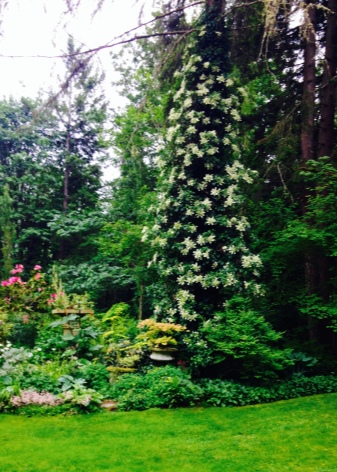
Popular varieties
When choosing a hydrangea variety, you need to pay attention to such a criterion as resistance to the unfavorable climate of the Moscow region in the winter. It is possible to single out the most popular fast-growing varieties in the Moscow region.
- Pinky Winky - This is a variety of hydrangea, reaching 2 m in height, with colored conical inflorescences. Their color is purplish pink at the base and white at the end. The flowering period lasts from August to October. The plant can be classified as frost-resistant, but it will not be superfluous to cover it for the winter.
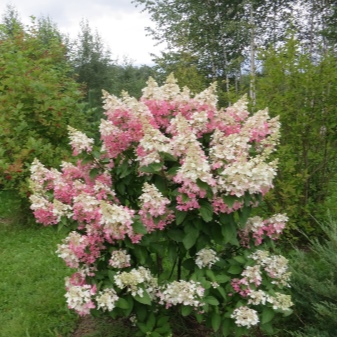

- Phantom - a tall representative with large-flowered inflorescences reaching 40 cm in diameter. It can be attributed to winter-hardy varieties, tolerates Moscow frosts well even without shelter. Phantom flowers at the beginning of the flowering season have a pale pink tint, but at the end they turn into a lilac color. The flowering period lasts from August to October.


- Pink Diamond recognized as one of the finest varieties. During the flowering period, the color of the flowers changes several times: in the spring they are white, in the summer they turn pink, and by the fall they acquire a crimson color. For wintering, it is better to cover young shrubs.


- Kyushu reaches a height of 3 m. Kyushu has inflorescences pointed in the form of pyramids with pale flowers, blooming from July to the end of October. They exude a delicate scent that attracts bees.


- Diamond Rouge - one of the most unusual representatives of hydrangea, a distinctive feature of which is a change in color not only of inflorescences, but also of foliage. Leaves of deep green color gradually turn orange. The flowers are white at the beginning of the season, but by September they take on a pink color. The height of this hydrangea variety reaches 1.5 m.


- Limelight reaches a height of 1 m, in rare cases 2 m, has a cap-like shape. Its inflorescences are densely covered with flowers, which are still greenish at the beginning of the season, but by the end of the season they acquire a pink color. Limelight prefers warm conditions, so it is better to plant it in a sunny area.


- Bobo refers to early flowering plants. This is a low-growing hydrangea, its height is no more than 0.8 m. The color of the inflorescences depends on the flowering period and is white, lemon and pink.


When choosing a hydrangea variety, an inexperienced gardener may be confused. Therefore, it is recommended to start with the most unpretentious representatives. These include some varieties of paniculate species.
- Grandiflora - the owner of large panicles with a diameter of 30 cm, the color of which is white at the beginning of the flowering season, pinkish by the end of summer and greenish-red in autumn. The flowering period lasts from the second half of June to October. Grandiflora reaches 2 m in height, loves moist soil and does not suffer from a lack of sunlight. Young seedlings will not immediately please with buds, they need time to strengthen the roots. Only at 4–5 years of life will the plant give its first inflorescences. Adult representatives of the variety are winter-hardy, as the shoots become woody and covered with bark.

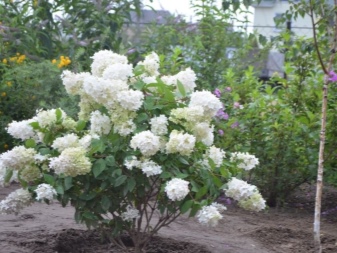
- Tardiva refers to late flowering varieties. With proper care, it can grow up to 3 m. Tardiva safely tolerates winter thanks to the early coverage of the branchy part with bark. Flowering begins in the second half of August, the color of the petals is creamy, eventually changing to pink.


- polar bear - a variety that got its name for its extraordinary frost resistance and snow-white flowers. The plant blooms until frost and tolerates temperatures down to -35 ° C. The polar bear is unpretentious in its habitat: it tolerates waterlogging, shading and polluted air. The shrub height reaches 1.7 m.


- Pastel Green - a frost-resistant variety of hydrangea (up to -30 ° C). Small neat shrub reaches 1.2 m in height. During the flowering season, the color of the petals repeatedly changes from white and cream shades to green and pink.


How to choose?
You can buy hydrangea seedlings in specialized stores. First you need to decide on the choice of a variety, since the final result depends on this.
One of the selection criteria is the location, conditions and quality of the soil. For garden plots of the Moscow region, paniculate, broad-leaved and climbing types of flower will be the best option.

Frost-resistant plant varieties grow well in this climatic zone.
- Paniculate view adapts well to the climatic conditions of the Moscow region. The plant is recommended to be purchased with a closed root system and planted in the garden in late spring. Therefore, when buying, you need to carefully examine the roots. Healthy roots will be strong, mold-free, and the soil moderately moist. A good seedling will have several strong shoots.
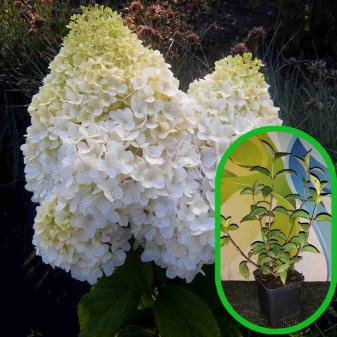

- If the choice fell on climbing hydrangeathen it is important to know that he does not like transplants. Therefore, before buying, you need to decide on the choice of permanent "place of residence" of the plant. A healthy seedling will have a well-developed root system. Climbing hydrangea roots grow more horizontally than in depth. Accordingly, the landing pits should be shallow, but wide enough.


- Broadleaf hydrangea belongs to the thermophilic species, therefore, it will require additional care. Young seedlings should not be grown immediately in the open field, since a plant that is too delicate will not survive the winter cold. The flower is recommended to be purchased in pots and kept indoors as a houseplant for several years. After 2-3 years, the hydrangea can be taken out to an area protected from the bright sun and drafts, and left for the summer to adapt.


Landing
Hydrangeas are an excellent purchase for gardeners. In order for this plant to please with lush flowering, you must adhere to several rules.
- Hydrangea takes root well in loams, so it is recommended to plant it in such a soil;
- Constant abundant soil moisture is required during the dry period.
- The plant loves good lighting, but does not tolerate direct bright sunlight (when choosing a site for planting, this factor is important to take into account).
- Hortense does not like drafts, it should be protected from this phenomenon.
- Every spring, it is necessary to prune the plant: old and broken branches are cut off. In the fall, you need to remove faded inflorescences.


Follow-up care
In the hot season, gardeners of the Moscow region need to take more care of the hydrangea: regularly spray the green part with water, and water the soil around the root system evenly. During the season, feeding is carried out with organic fertilizers, as well as solutions of nitrophos and superphosphate. Periodically, you need to prune dry and diseased branches. Thanks to this, the plant acquires a neat lush crown.


Hydrangea propagation is carried out in 3 ways: cuttings, seeds and layering. If the cultivation is carried out by seeds, then this will require a large pot of soil in which the seeds are planted in the fall. With systematic moistening of the soil, shoots will sprout after a while. In the spring, young shoots are used as cuttings and planted under a trimmed plastic bottle. Within a month, the plant is watered, it takes root.
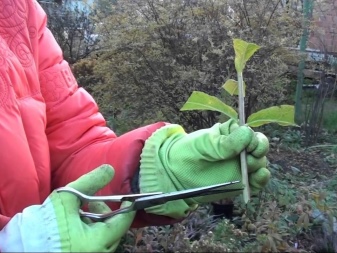

How do they winter?
After the hydrangea has thrown off all the foliage, its branches must be tied up, and the base of the shrub must be covered with mulch for the winter. The mulching layer will protect the plant's root system from the cold. In order for a young hydrangea to safely endure the winter and keep the buds on young shoots, it must be provided with additional shelter. It is important to carry out this procedure before the onset of frost, otherwise even 5 ° frost can destroy immature shoots.
Shelter plants for wintering begins with the installation of a wooden box or other suitable device on which the branches of the bush can be neatly laid. Then the plant is completely covered with spruce branches or non-woven covering material and fixed with ropes from all sides.
If sheltered correctly, hydrangea can withstand temperatures down to -40 °. Small shrubs can overwinter safely if they are completely covered with earth and covered with spruce branches on top.
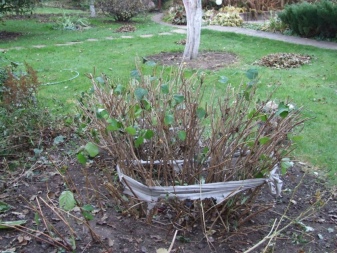

But the described methods of shelter are not suitable for adult and tall bushes with rigid branches... Therefore, structures are erected for them in a vertical arrangement: in a circle around a group of shrubs, stakes are driven into the ground, to which the plants are fixed with ropes. On top of them, they are wrapped with a covering material and covered with a film or roofing material. Previously, the base of each bush is mulched. Over the years, the root system of the hydrangea strengthens, and the branches become woody. Thus, the plant becomes frost-resistant and no longer needs additional shelter.

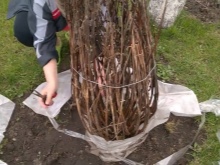

Examples of use in landscape design
The impressive appearance of the hydrangea attracts the attention of not only amateur gardeners, but also professionals in the field of landscape design. Lush greenery and chic blooms give the garden a stunning look. Hydrangea is combined with most flowering and decorative deciduous plants.

A single low bush will look good next to a bench. And a number of tall varieties of hydrangea will decorate the path to the garden. Landscape designers use various options for site design: hedge, single planting, garden alley framing, multi-tiered compositions in combination with other flowers.


An excellent company of hydrangeas can be lilies, azaleas, roses, spireas. Early flowering tall varieties of hydrangea in neighbors are ideal lilac bushes. The neighborhood of coniferous shrubs on the site will be beneficial, since the aroma of the needles scares off pests.


In autumn, asters and dahlias will be the best companions. The combination of hydrangea and bergenia, hosts and astilba will decorate the shore of the reservoir. Low-growing hydrangea shrubs can be planted in the same flower bed with geraniums and ornamental grass. If hydrangea bushes look lonely, then their company can be diluted with tree peonies.


When decorating a plot with compositions of thermophilic varieties of hydrangea and other flowers, it is necessary to take into account the characteristics of neighboring plants and plant species that, like hydrangea, need warming in the winter season.

Next, see the video review of hydrangea varieties.



































































The comment was sent successfully.